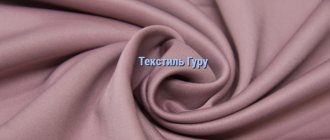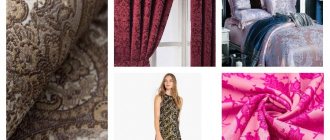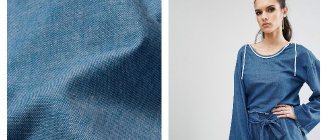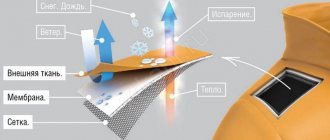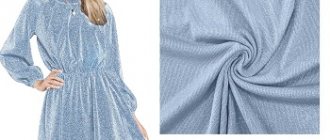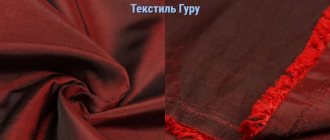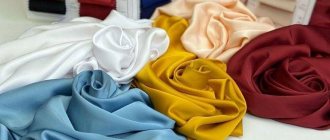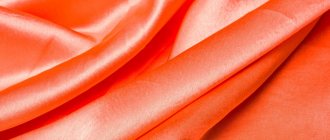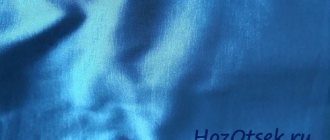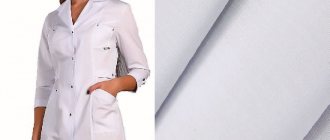Teak fabric: let's talk about the composition, give a description of the material, tell you what it is and whether it is natural or not, as well as how much it costs and customer reviews. This material had limited use during the Middle Ages and was used for sewing clothes for the poor and fashionable slimming corsets. In the 70s of the last century, it began to be used in the manufacture of scarves and backpacks, as well as safari dress models. The name “tick” is translated from English as “cover”. Today, indeed, the material is used more as a cover, or rather a napper for blankets, pillows and feather beds. Teak fabric has a 100% natural composition, and its description and photo confirm that the material is produced using twill or plain weave threads.
Description and properties
Teak is a thick cotton or linen fabric with a plain, twill or satin weave between the weft and warp. In the production of the material, thick threads of yarn are used, so the output of the weaving machine is fabric with a density of 140-160 g/m2. At the same time, there are different canvases in width; below are their descriptions.
Advantages of the material:
- strength;
- durability;
- shape retention and low creasing;
- abrasion resistance;
- hygroscopicity;
- hypoallergenic (applies only to fabric without synthetic additives);
- breathability.
There are also disadvantages:
- difficulty sewing due to density;
- moisture absorption. When storing material at high humidity, it becomes heavily saturated with water and does not dry well;
- low contrast and brightness of patterns and colors in mattress types of fabric. This feature is caused by the use of coarse yarn from natural raw materials, which does not have a pronounced shine.
Twill-Satin
This is a twill fabric made on the basis of cotton threads. The twill fabric itself can have a wool, silk, or cotton structure, since it determines the type of weave, not the origin of the threads. Since in the case of cotton threads, twill fabric strongly resembles satin in appearance, the name Twill-Satin is especially used for it. Twill (twill-satin) is a twill weave fabric. A scar is clearly visible in its structure, both visually and to the touch. It perfectly allows air to pass through and allows the skin to “breathe.” The fabric is woven from tightly twisted cotton threads, which gives it shine and smoothness. It is used for the production of bed linen, which is characterized by low creasing, high wear resistance, and dries well.
View the offer for Twill-Satin fabric
Fabric design gallery Active dye satin, made in China, 100% cotton, width 228 cm.
General characteristics
The fabric has good wear resistance, is practical and does not cause allergic reactions. Feather teak is smooth to the touch and rustles a little. The mattress material is rough and has a rough surface. All types are similar in strength.
| Characteristic | Indicators |
| Compound | Cotton; linen; polyester |
| Strength | High |
| Weave | Polotnyanoye |
| Antistatic | Yes |
| Hygroscopicity | Absorbs moisture well |
| Impregnation | Only in feathered species |
| Manufacturers | China, Pakistan, Russia, Korea |
Poplin
Plain weave cotton fabric, also called “improved” calico. It has the same properties as Calico, but has greater wear resistance (the threads are twisted more tightly). Poplin is also softer and more pleasant to the touch. Poplin is available in both bleached and dyed forms: multi-colored, printed and plain-dyed. The scope of poplin is quite wide. Due to its softness, poplin is popular for sewing women's dresses, men's shirts, tablecloths, and towels. However, Poplin is most often used for the production of bed linen.
Poplin bed linen retains its shape and color well, has a pleasant surface to the touch, retains heat well and absorbs moisture, and almost does not wrinkle. In addition, poplin bed linen does not require special care. Poplin fabric is hypoallergenic and meets all European environmental standards. And finally, such bed linen, for all its high performance qualities, is relatively inexpensive. In addition to regular poplin fabric, fabric with a 3D effect is often used for bed linen. The 3D effect is achieved due to the special diagonal weave of the material threads that form the fabric.
See the photo gallery of poplin designs for bed linen (220 cm, 105 g/m2, 100% cotton)
Appearance
Teak stains well and does not fade. With impregnation it has a slight shine, other types are matte.
Types of matter:
- With a single color - the canvas is painted in one color.
- Printed - that is, the pattern is applied to the finished fabric, which has a rich palette of colors and patterns.
- Multicolored. Yarn of various colors is used in production. An example is the familiar mattresses.
Fule
Pile fabric with a twill weave, 100% cotton. It is used for sewing men's and children's shirts, and can also serve as a lining for jackets and knitwear.
A characteristic feature of Fule is the checkered pattern - classic and modern, large and small, strict and bright checks, woven from multi-colored threads. Due to the twill weave, Fule fabric looks like coarse wool, while being soft to the touch like flannel. At the same time, always in a cage. It seems that this fabric combines the classic charm of tartan with the warmth and comfort of flannel. Thanks to the use of high-quality yarn and stable dyes in the production of the fabric, a long service life of the products is guaranteed.
View the offer of Fule fabrics
TOWEL FABRICS
Waffle fabric
Waffle fabric is a cotton fabric with high hygroscopicity for the manufacture of towels and cleaning wipes. Our company offers waffle fabric of several densities that are most in demand on the market:
- width 45 cm density 125 g/sq.m (bleached)
- width 45 cm density 144 g/sq.m (bleached and printed)
- width 50 cm density 200 g/sq.m (bleached)
Catalog of waffle fabric designs.
RETURN TO CATALOG
- polyester
Kinds
Feather (down-containing). Producers are China and Pakistan. The fabric is hard to the touch, you can feel the impregnation, you can see the shine, and when it is wrinkled, you can hear a rustling sound. This fabric is mainly used for feather pillows and also serves as a cover for blankets.
- width 220 cm;
- density 140 g/m2;
- Composition: 35% cotton, 65% polyethylene.
Pillow teak. Russia also produces teak. In the city of Orekho-Zuevo they produce dense fabric that is hard to the touch.
- Density - 140 +/-5 g/m2;
- Width - from 80 or 160 cm;
- Composition: 100% cotton.
Mattress. Teak is also produced for feather beds and mattresses. This is the same striped look. This material is not impregnated, but has a high density, which makes it durable.
- Density - 162 +/-9 g/m2;
- Width - 90; 160; 180; 220 cm;
- Composition: 100% linen or cotton.
Fabric Features
The material is obtained by plain or twill weave. Teak itself is considered a natural fabric. In terms of tactile sensations, despite its density, the material is quite soft. Its surface can be either smooth or ribbed. Teak fabric is most often used for sewing covers for pillows, blankets, and mattresses.
Teak fabric
Canvas is often confused with poplin or satin, but unlike them, teak has no shine and is much stronger. This is important especially for products made from feather or down, so that the filler stays inside better.
At the time of its appearance, teak was available only to rich people, but over time the volume of its production increased greatly and the fabric became available to all segments of the population.
Variety of colors
Application
The area of application of the material is in need of density and wear resistance. This is sewing pillow covers and mattress covers. Impregnated teak is used for feather pillows and mattresses. But among other things, the material is used not only as bedding.
Fabrics with a lower density are used to make curtains and drapes. Bed linen and work clothes are made from it, and the lightest one is also used for clothes.
Dense material is used for furniture covers, all kinds of awnings and even fabric blinds.
Blankets and other things made from colored teak last for years without losing their quality or color. This is evidenced by numerous reviews from owners of products made from this fabric.
Teak
Dense fabric of twill or plain weave threads with longitudinal wide variegated or printed colored stripes. The two most important features of teak that determine the scope of its application are the natural source material and the high density of the resulting fabric. Teak is woven only from linen or cotton yarn. Therefore, it can be safely used in the manufacture of clothing, bed linen, furniture upholstery - anything that comes into direct contact with the skin. The high density of teak is achieved due to a special strong weave of threads. Most often, when making teak, plain weave is used, in which the upper and lower threads change places at each step, as a result they are arranged in a checkerboard pattern. This is the simplest and most durable weaving method. The second option used for the production of teak is twill weave, which results in a ribbed fabric with clearly noticeable raised diagonal stripes. The high density of teak has made it the most popular material for making bedsteads - fabric coverings for pillows and mattresses. The colors of teak fabric can be very different . The simplest option, striped, has long been strongly associated with striped mattresses. The diagonal stripe on the ribbed fabric is also used in the manufacture of various kinds of napkins, which will still be dressed in more elegant bed linen on top. And there are many more options for coloring teak fabric for making furniture upholstery. It is possible to create interweaving patterns, paintings with numerous shades, etc.
View Tika's offer
Product care
Caring for things is easy.
The material can be washed in washing machines on any mode, since due to its density it does not shrink.
Ironing of products is done with a well-heated iron.
The only exception is impregnated teak. To wash it, you need a more gentle mode, water with a temperature of no more than 40°C without the use of bleaching agents. It is necessary to wash clothes at the same temperature to avoid shrinkage of the material.
And also pay attention to storing things. The room for it must be ventilated. If this is not the case, then things need to be periodically taken out and dried, since teak tends to absorb moisture from the air. Although linen does not deteriorate for a long time in dampness, mold develops on things, which will hopelessly ruin them, and cotton fabric will lose strength. Wet things cake heavily and lose their shape.
conclusions
- Teak is a very practical and durable material that is used in various industries.
- To create teak fabric, only natural fabrics are used - linen, cotton or hemp.
- Various things are sewn, but it is mainly used to create bedsteads and mattress covers, as well as in the furniture industry.
- Despite the versatility of the fabric, teak items must be cared for in a certain way. In particular, you should not use aggressive chemicals when washing to avoid damage.
Excursion into history
In the 18th century, compacted linen linens were called differently:
- revelry;
- meal.
The term “zatrapeza” comes from the name of the merchant who made the fabric. Later, another name arose - “tijk” (Dutch). Presumably, this happened during the communication between Peter’s Russian envoys and the Dutch residents. The modern name "tick" is attributed to European origin.
In the 18th-19th centuries, dense fabric made from cheap raw materials was intended for long-term use. She went to sewing clothes for the lower classes of the population and fashionable slimming corsets. Teak was considered low-grade, so the aristocracy was surprised when Gogol ordered a teak suit for himself in Hamburg. To which the writer replied: “Tick is a cheap, comfortable material that washes well.”
Fabrics in natural shades made from natural raw materials have always been highly valued.
Teak, which has established itself as a reliable and durable material, began to be used in the production of tents and backpacks in the middle of the last century. And in the 70s, fashionable dresses and safari jackets were made from it.
Today the fabric is widely used as bedsteads, mattresses and blinds.
Wash
There are no special recommendations on how to wash teak. Teak tolerates both hand and machine washing. This concerns the material itself. But if there is a pillow or blanket in the teak bedstead, you should follow the manufacturer's recommendations when washing.
If the pillow is filled with natural feathers, the pillowcase should be removed and washed separately. If the filling is synthetic, then the pillow can be washed either manually or in an automatic machine.
In this case, despite the durability of the material, you need to pay attention to certain recommendations:
- With an acceptable threshold of 90 degrees, the optimal temperature range is 50−60
- If the teak is colored, it is better to wash it at forty degrees
- White fabric can be washed with any powder
- Colored teak is washed with shade-restoring agents.
Dry in the fresh air, preferably without direct sunlight.
Kashkorse is a soft knitwear with a special knitting technique: properties and application of the fabric
Varieties
We already know what kind of fabric teak is, all that remains is to consider the purpose of its types. The purpose of the types of fabric directly depends on its density:
- Teak for mattresses is rough, and its density is the highest (160 g/m2);
- Teak for pillowcases with a lower density (140 g/m2), allows you to make fabrics that are softer and more pleasant, but still retain the down and feather mass; such teak is also called down-holding teak;
- Teak for curtains is the most pleasant type of teak to the touch.
It is the density and composition of matter that directly determine its cost. As for the colors and patterns, the flight of imagination is unstoppable. Teak can be plain and variegated or have a printed pattern (pre-prepared threads of different colors are applied to the teak cloth)
Jersey: fabric features and area of application of the material
Ironing
Teak can be ironed equally well on both sides, front and back. It is best to iron slightly damp, not yet dry material. If the fabric is dry, a spray bottle will come to the rescue.
As for temperatures, the following recommendations should be followed:
- Teak made from pure cotton is ironed at 140-170 degrees
- Teak based on linen - at 180−200.
Both types of teak can be steamed. Please note that pure white teak should only be ironed with a well-heated iron, otherwise yellow spots will appear on the material.

